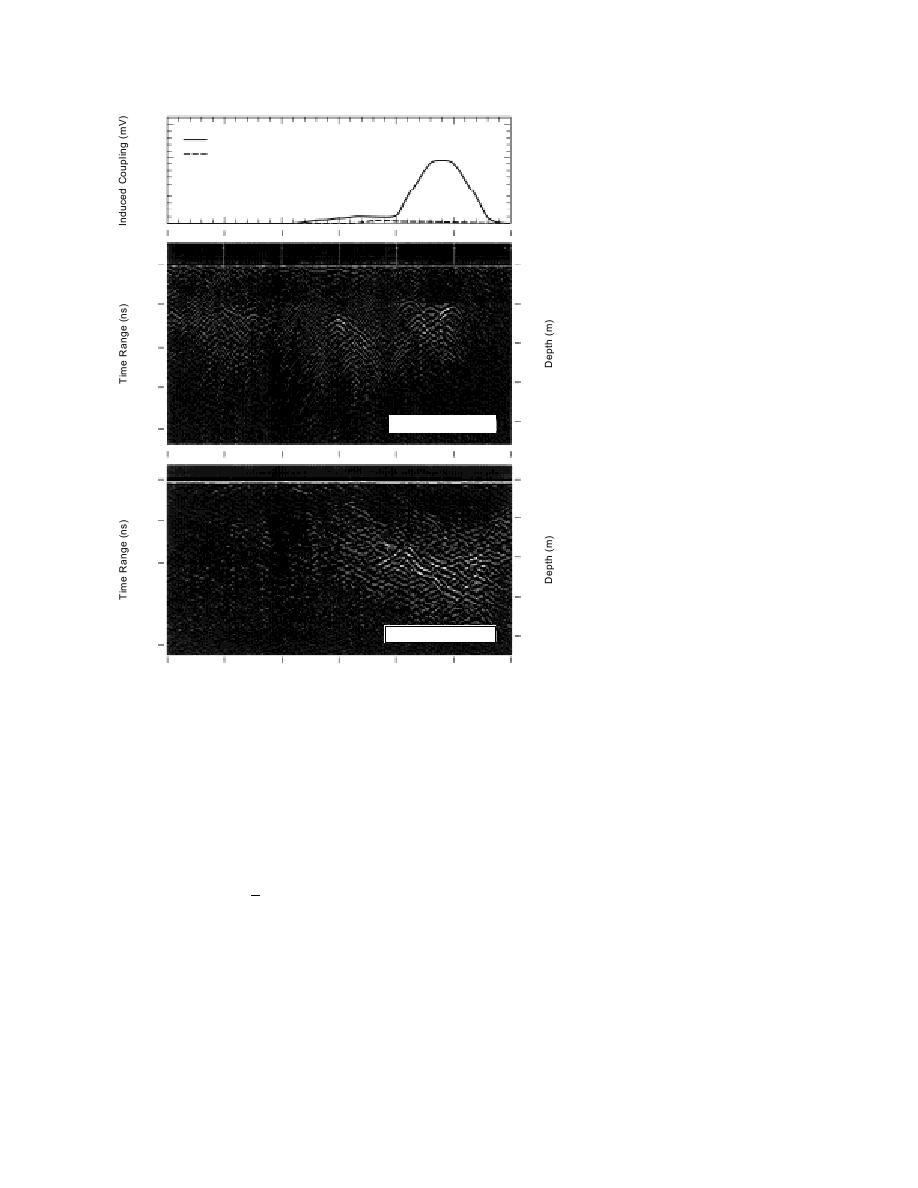
The post-excavation EMI plot (top,
Distance (m)
Fig. 7) confirms this.
30
25
20
15
10
5
0
1500
Figure 8 shows GPR and EMI
data recorded along transect 11.
Pre-excavation EMI
The pre-excavation profiles (top
Post-excavation EMI
1000
and middle) show a highly dis-
500
turbed area that includes intense
diffractions with nearly symmetri-
0
cal hyperbolas. These diffractions
were interpreted as metallic, cylin-
drical objects because of the strong
0
0
secondary diffractions generated
beneath them (Lawson et al. 1994).
1
20
Secondary diffractions are charac-
teristic responses from the inter-
2
40
section between closely spaced
cylinders. Similar diffractions occur
3
60
on several adjacent profiles, indi-
cating the presence of substantial
4
Pre-excavation GPR
amounts of buried metal. The pre-
80
excavation EMI plot of a broad,
high-amplitude anomaly confirms
the presence of metallic objects
0
0
along a 15-m segment of this
transect. More than fifty 55-gal.
1
20
steel barrels were removed from
this zone. Many of the barrels were
2
40
intact, which probably contributed
to the symmetrical GPR anomalies.
3
The post-excavation GPR profile
60
(bottom) still shows some arti-
Post-excavation GPR
4
facts where the hyperbolas were
80
previously located. This could
point to some small amount of
Figure 8. Profiles recorded along transect 11 (area A-3) with GPR and
metal remaining off-line; however,
EMI. The excavation revealed fifty 55-gal. (208-L) steel barrels in the
the post-excavation EMI survey
area distinguished by the broad EMI anomaly and the distinct GPR
revealed no substantial anomaly.
hyperbolic reflections.
The sloping GPR horizon seen on
the post-excavation profile may be
firms this interpretation, showing a narrow high-
a soil horizon compacted by the excavation pro-
amplitude anomaly and a broad, low-amplitude
cess or it may be an old soil horizon previously
anomaly. The narrow anomaly denotes shallow
obscured by the diffractions from the drums.
burial of metallic items, while the broad anomaly
The results of the post-excavation GPR profiles
evidences a more substantial target that is buried
are summarized in Figure 9. The contoured area
deeper. The excavation resulted in removal of
corresponds to anomalies at a depth of 1 to 4 m.
3 ( 3 1 m3) of scrap metal, 55-gal.
more than 5 yd
Profiles recorded on transects 000 through 03
2
(208-L) drums, and other debris from the zone
showed no detectable horizons. Most of the area
beneath the broad anomaly. Material recovered
within these transects was excavated in 1994, and
from the zone beneath the narrow anomaly in-
we attribute the lack of strong returns in the GPR
cluded 5-gal. (19-L) pails, metal funnels, and
data to signal attenuation in the silty gravels used
contaminated soil. The GPR profile recorded
as backfill. The remainder of the profiles (0421)
after excavation and backfill is also shown in
showed a zone with few or no signal returns near
Figure 7. The lack of any sustained reflections in
the top of the record, which also probably
this profile means that all debris was removed.
resulted from signal attenuation in the silty fill
8



 Previous Page
Previous Page
